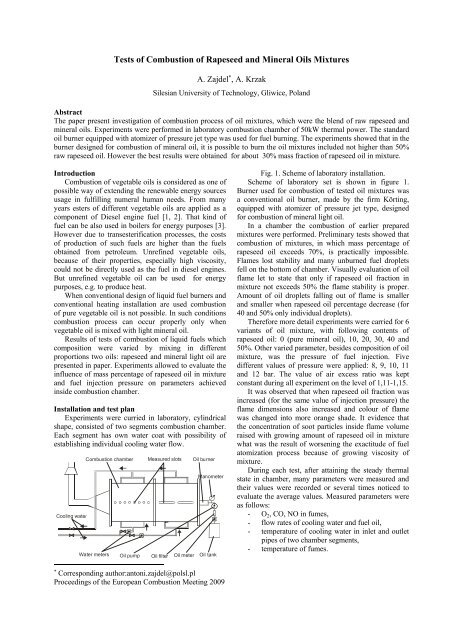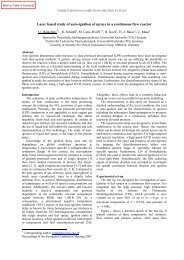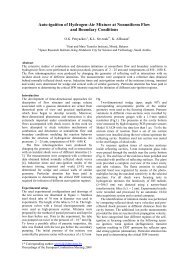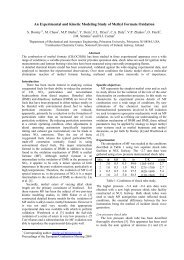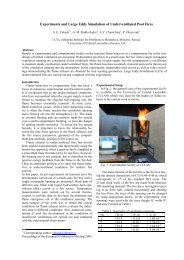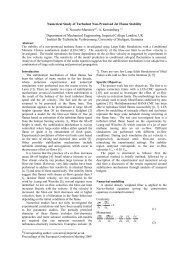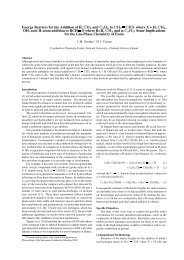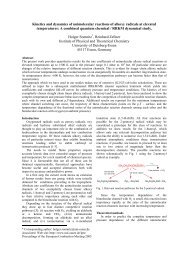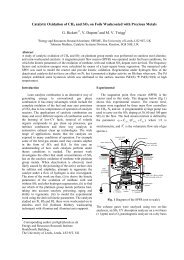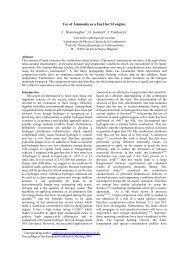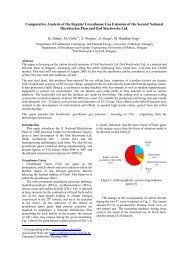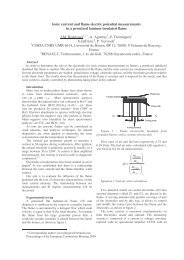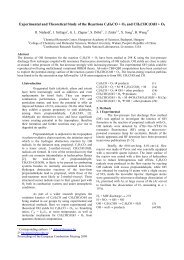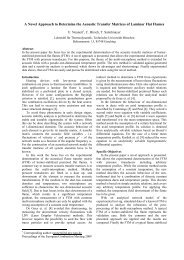Tests of Combustion of Rapeseed and Mineral Oils Mixtures
Tests of Combustion of Rapeseed and Mineral Oils Mixtures
Tests of Combustion of Rapeseed and Mineral Oils Mixtures
Create successful ePaper yourself
Turn your PDF publications into a flip-book with our unique Google optimized e-Paper software.
<strong>Tests</strong> <strong>of</strong> <strong>Combustion</strong> <strong>of</strong> <strong>Rapeseed</strong> <strong>and</strong> <strong>Mineral</strong> <strong>Oils</strong> <strong>Mixtures</strong><br />
A. Zajdel ∗ , A. Krzak<br />
Silesian University <strong>of</strong> Technology, Gliwice, Pol<strong>and</strong><br />
Abstract<br />
The paper present investigation <strong>of</strong> combustion process <strong>of</strong> oil mixtures, which were the blend <strong>of</strong> raw rapeseed <strong>and</strong><br />
mineral oils. Experiments were performed in laboratory combustion chamber <strong>of</strong> 50kW thermal power. The st<strong>and</strong>ard<br />
oil burner equipped with atomizer <strong>of</strong> pressure jet type was used for fuel burning. The experiments showed that in the<br />
burner designed for combustion <strong>of</strong> mineral oil, it is possible to burn the oil mixtures included not higher than 50%<br />
raw rapeseed oil. However the best results were obtained for about 30% mass fraction <strong>of</strong> rapeseed oil in mixture.<br />
Introduction<br />
<strong>Combustion</strong> <strong>of</strong> vegetable oils is considered as one <strong>of</strong><br />
possible way <strong>of</strong> extending the renewable energy sources<br />
usage in fulfilling numeral human needs. From many<br />
years esters <strong>of</strong> different vegetable oils are applied as a<br />
component <strong>of</strong> Diesel engine fuel [1, 2]. That kind <strong>of</strong><br />
fuel can be also used in boilers for energy purposes [3].<br />
However due to transesterification processes, the costs<br />
<strong>of</strong> production <strong>of</strong> such fuels are higher than the fuels<br />
obtained from petroleum. Unrefined vegetable oils,<br />
because <strong>of</strong> their properties, especially high viscosity,<br />
could not be directly used as the fuel in diesel engines.<br />
But unrefined vegetable oil can be used for energy<br />
purposes, e.g. to produce heat.<br />
When conventional design <strong>of</strong> liquid fuel burners <strong>and</strong><br />
conventional heating installation are used combustion<br />
<strong>of</strong> pure vegetable oil is not possible. In such conditions<br />
combustion process can occur properly only when<br />
vegetable oil is mixed with light mineral oil.<br />
Results <strong>of</strong> tests <strong>of</strong> combustion <strong>of</strong> liquid fuels which<br />
composition were varied by mixing in different<br />
proportions two oils: rapeseed <strong>and</strong> mineral light oil are<br />
presented in paper. Experiments allowed to evaluate the<br />
influence <strong>of</strong> mass percentage <strong>of</strong> rapeseed oil in mixture<br />
<strong>and</strong> fuel injection pressure on parameters achieved<br />
inside combustion chamber.<br />
Installation <strong>and</strong> test plan<br />
Experiments were curried in laboratory, cylindrical<br />
shape, consisted <strong>of</strong> two segments combustion chamber.<br />
Each segment has own water coat with possibility <strong>of</strong><br />
establishing individual cooling water flow.<br />
Cooling water<br />
<strong>Combustion</strong> chamber<br />
Measured slots Oil burner<br />
Manometer<br />
Water meters Oil pump Oil filter Oil meter Oil tank<br />
∗ Corresponding author:antoni.zajdel@polsl.pl<br />
Proceedings <strong>of</strong> the European <strong>Combustion</strong> Meeting 2009<br />
Fig. 1. Scheme <strong>of</strong> laboratory installation.<br />
Scheme <strong>of</strong> laboratory set is shown in figure 1.<br />
Burner used for combustion <strong>of</strong> tested oil mixtures was<br />
a conventional oil burner, made by the firm Körting,<br />
equipped with atomizer <strong>of</strong> pressure jet type, designed<br />
for combustion <strong>of</strong> mineral light oil.<br />
In a chamber the combustion <strong>of</strong> earlier prepared<br />
mixtures were performed. Preliminary tests showed that<br />
combustion <strong>of</strong> mixtures, in which mass percentage <strong>of</strong><br />
rapeseed oil exceeds 70%, is practically impossible.<br />
Flames lost stability <strong>and</strong> many unburned fuel droplets<br />
fell on the bottom <strong>of</strong> chamber. Visually evaluation <strong>of</strong> oil<br />
flame let to state that only if rapeseed oil fraction in<br />
mixture not exceeds 50% the flame stability is proper.<br />
Amount <strong>of</strong> oil droplets falling out <strong>of</strong> flame is smaller<br />
<strong>and</strong> smaller when rapeseed oil percentage decrease (for<br />
40 <strong>and</strong> 50% only individual droplets).<br />
Therefore more detail experiments were carried for 6<br />
variants <strong>of</strong> oil mixture, with following contents <strong>of</strong><br />
rapeseed oil: 0 (pure mineral oil), 10, 20, 30, 40 <strong>and</strong><br />
50%. Other varied parameter, besides composition <strong>of</strong> oil<br />
mixture, was the pressure <strong>of</strong> fuel injection. Five<br />
different values <strong>of</strong> pressure were applied: 8, 9, 10, 11<br />
<strong>and</strong> 12 bar. The value <strong>of</strong> air excess ratio was kept<br />
constant during all experiment on the level <strong>of</strong> 1,11-1,15.<br />
It was observed that when rapeseed oil fraction was<br />
increased (for the same value <strong>of</strong> injection pressure) the<br />
flame dimensions also increased <strong>and</strong> colour <strong>of</strong> flame<br />
was changed into more orange shade. It evidence that<br />
the concentration <strong>of</strong> soot particles inside flame volume<br />
raised with growing amount <strong>of</strong> rapeseed oil in mixture<br />
what was the result <strong>of</strong> worsening the exactitude <strong>of</strong> fuel<br />
atomization process because <strong>of</strong> growing viscosity <strong>of</strong><br />
mixture.<br />
During each test, after attaining the steady thermal<br />
state in chamber, many parameters were measured <strong>and</strong><br />
their values were recorded or several times noticed to<br />
evaluate the average values. Measured parameters were<br />
as follows:<br />
- O2, CO, NO in fumes,<br />
- flow rates <strong>of</strong> cooling water <strong>and</strong> fuel oil,<br />
- temperature <strong>of</strong> cooling water in inlet <strong>and</strong> outlet<br />
pipes <strong>of</strong> two chamber segments,<br />
- temperature <strong>of</strong> fumes.
Values <strong>of</strong> some measured parameters were used to<br />
calculate the other parameters, which characterize tested<br />
process thermally, such as: thermal power <strong>of</strong> burner,<br />
heat flux absorbed by water cooling the chamber walls<br />
<strong>and</strong> effectiveness <strong>of</strong> energy transfer process inside<br />
combustion chamber.<br />
Physical characteristics <strong>of</strong> rapeseed oil were<br />
measured by many investigators [4, 5]. Data from these<br />
papers <strong>and</strong> our own measurements are very similar, e.g.<br />
LHV <strong>of</strong> mineral oil is 42.5 MJ/kg <strong>and</strong> rapeseed oil 36.9<br />
MJ/kg. These values were use for calculation <strong>of</strong> burner<br />
thermal power.<br />
Results <strong>and</strong> Discussion<br />
Results <strong>of</strong> measurements <strong>and</strong> calculations are<br />
presented in figures 2-7. Each graph shows the<br />
influence <strong>of</strong> growing percentage <strong>of</strong> rapeseed oil (in<br />
mixture with mineral oil) on the values <strong>of</strong> different<br />
parameters. Particular curves on each graph refer to<br />
different values <strong>of</strong> injection pressure.<br />
In fig.2 it is seen how differed the oil burner<br />
capacity with variation <strong>of</strong> rapeseed oil fraction in<br />
mixture for different values <strong>of</strong> injection pressure.<br />
oil burner capacity kg/h<br />
4.0<br />
3.5<br />
3.0<br />
2.5<br />
2.0<br />
0 10 20 30 40 50<br />
rapeseed oil fraction %<br />
&8 bar %9 bar C10 bar /11 bar "12 bar<br />
Fig. 2. Effect <strong>of</strong> the composition <strong>of</strong> mixture <strong>and</strong> the<br />
pressure <strong>of</strong> injection on burner capacity.<br />
It is obvious that the higher oil pressure cause the<br />
higher oil rate in the burner. When rapeseed oil<br />
percentage rises the mixture has higher density <strong>and</strong><br />
higher viscosity. Higher fluid viscosity causes higher<br />
resistance <strong>of</strong> flow. It is seen that, in tested range <strong>of</strong><br />
mixture composition, the influence <strong>of</strong> density growth<br />
predominates the flow resistance growth <strong>and</strong> in<br />
consequence the mass flow rate <strong>of</strong> mixture rises with<br />
rapeseed oil percentage growth.<br />
Value <strong>of</strong> mass flow rate <strong>of</strong> oil mixture leaving the<br />
burner influences the thermal power <strong>of</strong> burner. In fig.3<br />
the thermal power <strong>of</strong> burner for tested variants <strong>of</strong><br />
combustion process is shown. For each pressure <strong>of</strong> oil<br />
injection the thermal power <strong>of</strong> burner, which is a<br />
product <strong>of</strong> two values: oil mass flow rate <strong>and</strong> oil low<br />
heat value, remains almost constant. In tested range <strong>of</strong><br />
2<br />
mixture composition, as the fraction <strong>of</strong> rapeseed oil<br />
rises, the product <strong>of</strong> oil mass flow rate, which also rises<br />
burner thermal power kW<br />
48<br />
44<br />
40<br />
36<br />
32<br />
28<br />
0 10 20 30 40 50<br />
rapeseed oil fraction %<br />
&8 bar %9 bar C10 bar /11 bar "12 bar<br />
Fig. 3. Effect <strong>of</strong> the composition <strong>of</strong> mixture <strong>and</strong> the<br />
pressure <strong>of</strong> injection on thermal power <strong>of</strong> oil burner.<br />
<strong>and</strong> oil low heat value, which decreases, gains slight<br />
maximum for about 30% <strong>of</strong> rapeseed oil in mixture.<br />
Concentration <strong>of</strong> CO <strong>and</strong> NO in waste gases leaving<br />
the chamber are presented in figures 4 <strong>and</strong> 5.<br />
CO emission (3% O 2 ) ppm<br />
700<br />
600<br />
500<br />
400<br />
300<br />
200<br />
100<br />
0<br />
0 10 20 30 40 50<br />
rapeseed oil fraction %<br />
&8 bar %9 bar C10 bar /11 bar "12 bar<br />
Fig. 4. Concentration <strong>of</strong> CO in waste gases versus<br />
rapeseed oil fraction for different values <strong>of</strong> injection<br />
pressure.<br />
It is seen that influence <strong>of</strong> pressure <strong>of</strong> oil injection<br />
on CO <strong>and</strong> NO emission is not evident. From others the<br />
results obtained for 8 bar, the lowest value <strong>of</strong> pressure,<br />
distinguished most clearly. When pressure <strong>of</strong> fuel<br />
injection has the lowest value the atomization <strong>of</strong> oil is<br />
least fine <strong>and</strong> combustion <strong>of</strong> fuel occurs with small<br />
intensity. Burner capacity is also lowest for this<br />
pressure. From these reasons the temperature inside<br />
combustion chamber, in that cases, have the lowest<br />
level. When temperature in combustion area is low<br />
more CO <strong>and</strong> less NO are created.
With growth <strong>of</strong> rapeseed oil percentage a viscosity<br />
<strong>of</strong> mixture rises <strong>and</strong> atomization process goes worse. In<br />
such conditions fuel burning can occur not complete <strong>and</strong><br />
NO emission (3% O2) ppm<br />
60<br />
50<br />
40<br />
30<br />
20<br />
0 10 20 30 40 50<br />
rapeseed fraction %<br />
&8 bar %9 bar C10 bar /11 bar "12 bar<br />
Fig. 5. Concentration <strong>of</strong> NO in waste gases versus<br />
rapeseed oil fraction for different values <strong>of</strong> injection<br />
pressure.<br />
amount <strong>of</strong> CO rises. Conditions, which are favorable for<br />
CO creation as general cause NO emission decrease.<br />
Main goal <strong>of</strong> fuel combustion process in a boiler is<br />
transfer <strong>of</strong> energy to heated medium. Heat absorbed by<br />
water cooling the chamber walls shows how intensively<br />
this process occurs. Values <strong>of</strong> heat fluxes absorbed by<br />
water flowing through cooling coat <strong>of</strong> chamber walls<br />
are presented in fig. 6.<br />
heat flux absorbed by water kW<br />
22<br />
21<br />
20<br />
19<br />
18<br />
17<br />
16<br />
15<br />
0 10 20 30 40 50<br />
rapeseed oil fraction %<br />
&8 bar %9 bar C10 bar /11 bar "12 bar<br />
Fig. 6. Heat absorbed by cooling water for different<br />
values <strong>of</strong> rapeseed oil fraction <strong>and</strong> injection pressure.<br />
Dependences showed in fig. 6. are very similar to<br />
those ones showed in fig. 3. It results from fact that heat<br />
fluxes transferred to heated medium depend, in<br />
combustion chamber, first <strong>of</strong> all, on thermal burner<br />
power at the moment. Higher burner power affords<br />
higher values <strong>of</strong> heat fluxes inside combustion chamber.<br />
However, the magnitude <strong>of</strong> heat fluxes did not<br />
inform about thermal perfection <strong>of</strong> energy transfer<br />
process. Effectiveness <strong>of</strong> energy transfer process taking<br />
3<br />
place inside combustion chamber is expressed by the<br />
ratio <strong>of</strong> two values: heat flux transferred to heated<br />
medium <strong>and</strong> burner power (release energy). In fig. 7<br />
effectiveness <strong>of</strong> heating the water inside the chamber is<br />
presented. The level <strong>of</strong> obtained effectiveness values is<br />
rather low, however in that case the comparison <strong>of</strong><br />
tested variants is more important thing.<br />
effectiveness %<br />
54<br />
52<br />
50<br />
48<br />
46<br />
44<br />
42<br />
40<br />
0 10 20 30 40 50<br />
rapeseed oil fraction %<br />
&8 bar %9 bar C10 bar /11 bar "12 bar<br />
Fig. 7. Effectiveness <strong>of</strong> energy transfer process<br />
occurring inside chamber fired by oil mixtures.<br />
It is seen that higher values <strong>of</strong> effectiveness are<br />
achieved for lower values <strong>of</strong> oil injection pressure.<br />
Explanation <strong>of</strong> such effect is as follows.<br />
When the pressure <strong>of</strong> oil injection rises the<br />
atomization process proceeds more exactly <strong>and</strong> obtained<br />
oil droplets have smaller sizes. <strong>Combustion</strong> process<br />
occurs more intensively <strong>and</strong> oil flame, in spite <strong>of</strong> higher<br />
temperature, radiates less amount <strong>of</strong> heat. The main<br />
reason <strong>of</strong> this is the lower concentration <strong>of</strong> soot particles<br />
inside flame volume. Soot concentration inside the<br />
flame influences decisively on intensity <strong>of</strong> flame<br />
radiation. So it is seen that energy effects are higher<br />
when atomization process occurs not very perfect. From<br />
this point <strong>of</strong> view an increase <strong>of</strong> rapeseed oil in mixture<br />
is also pr<strong>of</strong>itable.<br />
Conclusions<br />
On base <strong>of</strong> our investigation it can be stated that if<br />
st<strong>and</strong>ard oil burner <strong>and</strong> st<strong>and</strong>ard combustion conditions<br />
are applied the pure raw rapeseed oil can not be used as<br />
substitute <strong>of</strong> mineral oil.<br />
<strong>Combustion</strong> process can occur only when rapeseed<br />
oil is mixed with light mineral oil. The best effects,<br />
from thermally <strong>and</strong> ecologically point <strong>of</strong> view (CO <strong>and</strong><br />
NO emission, not complete fuel burning), were<br />
observed when proportion <strong>of</strong> rapeseed oil to mineral oil<br />
in mixture was 30% to 70%.<br />
References<br />
[1] Z. Szlachta, Using rapeseed fuels in Diesel engines,<br />
Communication <strong>and</strong> telecommunication Publishing<br />
House, Warsaw 2002, (in Polish).
[2] W. Lotko, Using vegetable <strong>and</strong> hydrocarbon fuels in<br />
Diesel engines, Scientific-Technical Publishing<br />
House, Warsaw 1997, (in Polish).<br />
[3] G. Tashtoush, M. I. Al-Widyan, A. O. Al-Shyoukh,<br />
<strong>Combustion</strong> performance <strong>and</strong> emissions <strong>of</strong> ethyl<br />
ester <strong>of</strong> a waste vegetable iol in a water-cooled<br />
furnace, Applied Thermal Engineering 23 (2003)<br />
285-293.<br />
[4] D. Jóźwiak, A. Szlęk, Evaluation <strong>of</strong> rapeseed oil as<br />
a fuel for boilers, Power Engineering 6 (2006) 449-<br />
451 (in Polish).<br />
[5] J. San José Alonso, J.A. López Sastre, C. Romero-<br />
Ávila, E.J. López Romero, <strong>Combustion</strong> <strong>of</strong> rapeseed<br />
oil <strong>and</strong> diesel oil mixtures for use in the production<br />
<strong>of</strong> heat energy, Fuel Processing Technology 87<br />
(2006) 97-102.<br />
4


